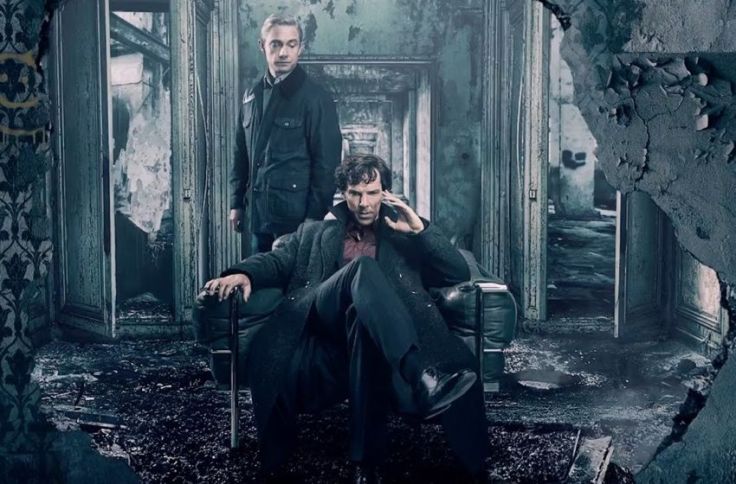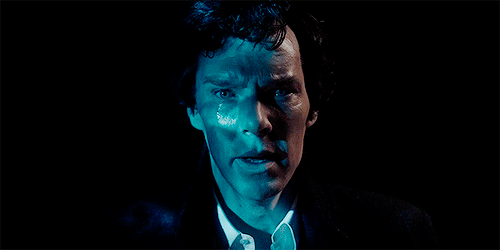Here dwell together still two men of note/ Who never lived and so can never die.
Here, though the world explode, these two survive,/And it is always eighteen ninety-five.*
Vincent Starrett’s poem 221B echoes a popular thought amongst those enthusiasts who, attracted by the promise of mysteries and crime-solving, knocked on the door of that painfully fictional London flat and immersed themselves in the world of Sherlock Holmes, Consulting Detective.
Still the only one in the world.
The same thought that Sherlock creators Steven Moffat and Mark Gatiss —the brilliant Mofftiss— have used to conclude —until further notice, it seems— their love letter to Arthur Conan Doyle’s masterpiece. A thought that has coursed through the veins of a much-awaited fourth season, the run of which has been bumpy and edgy, if anything else. And, because three episodes are never enough, and because we kind of thought Moriarty was actually not dead, the sentiment of wanting it to continue forever clashes dramatically against the urge to preserve it intact before it all goes awry. The final episode adverts us, “When all else fails, there are two men sitting, arguing in a scruffy flat, like they’ve always been there, and they always will.” But, is Sherlock’s incarnation one we want to see for the ages? Is season four a dignified finale to what one can only label an extraordinary series?

The Six Thatchers — Excessively spy-like, it derived too much from the Sherlock we are used to: impossible cases, quirky characters and a partnership to last for a lifetime. While globally as a series the first episode was needed —Mary turned out to be a quintessential part of the narrative of the second episode—, it flew way above what Sherlock needed or was comfortable with. The first half hour is solid Sherlock — the montage is classic, the jokes are on point and the characterization is nearly flawless. But from that point on, it delves into Bond territory and misses the mark.
For one, the predominance and subsequent predictable and because of it, slightly disappointing death of Ms. Is-Actually-A-Deadly-Spy Watson was miscalculated. Mary worked fine as a secondary character —a second plot added to the more important, predominant one. She was dynamic, morally ambiguous, complex and fun. The audience might not have empathized with her, but she was brilliant to write and include. And she dynamited Sherlock and John’s relationship in ways other characters simply don’t. But, giving to her the main storyline of the episode proved all of that wasn’t enough. She was never conceived as a main plot-driving character despite gaining importance in series three’s last episode. Mary was an addition to the show, made it richer. Instead, the AGRA storyline failed to create an emotional attachment to the audience —did we really care?— and fell flat as a main storyline.
One which was adorned with an out-of-character John Watson who, in true Ted Mosby style, seemed to go from brave and loyal to bored and adulterous. The balloon John placed in his chair so that Sherlock could talk to him acted more like John Watson than John Watson. If the intention was to create tension in his marriage —and I do suspect it was— it was definitely not the way to do it. Not only did it butcher the character, but it also diminished the power of his and Mary’s relationship.
Not cool.
Despite who the bus lady turned out to be. But more on that later.

The Lying Detective — The single greatest piece of television this show has ever and will ever produce, it perfectly captured and synthesized that which makes Sherlock, Sherlock. The best Sherlock has always been the one that mixes the procedural, a-case-an-episode storyline, with the show’s larger mythology, and this episode did just that. The ingredients were similar to the ones that made memorable episodes like A Scandal in Belgravia and The Reichenbach Fall masterpieces: a worthy, morally and psychologically ambiguous villain —that could very well rival Moriarty— who seems to trump and beat the unbeatable Sherlock, a carefully carved rift between Sherlock and John, and Mrs. Hudson in a badass car kicking ass and taking names.
The episode was carefully planned and perfectly executed thanks to a brilliant script that reminded us of the show’s first two —and, if I may, better— seasons. There was tension, but there was also room for jokes. The scene in which John confesses his betrayal to Mary —whom he sees as if she was alive— as Sherlock watches and ultimately hugs him was a nearly perfect one that hit the core of the show. Irene Adler came back —although briefly— and gave us an insight to Sherlock we missed even without being present. There was a case, but it also tied in to the series’s larger arc —and here’s where things got very weird, very quickly. John’s mysterious bus romance was actually a fake daughter was actually his therapist who was actually, all along, the Holmes third sibling. Far-fetched? Maybe. Exhilarating and exciting? Most definitely.
In short, the episode’s mind-game quality —one very synonymous to Reichenbach— and twists and turns were evocative of the Sherlock we used to know, the one where everyone was two steps behind while Sherlock was five steps ahead and boasting about it. And yet it didn’t fail to grasp and incorporate the development, the change in the characters, the maturity of each and every one of them, and the thrilling chase of an enemy that might or might not have come back.

The Final Problem — More than adequately titled, it zigzagged constantly between the first episode of the season and the second one. Thrilling, scary at times, and incredibly and almost unbearably painful —a vivisection, to put it in Sherlock’s words—, it provoked in the audience the spectrum of feelings it wanted to and left little time for us to consider the actual narrative choices surrounding it. It constantly questioned the characters’ moral, their development, their trust and their bonds. If one had to label it as something, it would most definitely be a character-defining episode. It took everything the characters —a much more humane Sherlock, a back-to-normal John and a well-rounded Mycroft— had gone through and synthesized it to finally consolidate the characters we have always known.
Eurus —psychopathic, murderous, out of control— seemed to be the overarching power that has always reigned above every other evil on the show. For better or for worse, she seemed to take part —did she fuel it or did she start it?— in Moriarty’s obsession with Sherlock, who, once again, remained the focal point of the story. The discovery and inquiry of the Holmes brothers’ —and sister now— past was asked for —by the fans, and I include myself in this collective— and delivered perhaps a little too strongly. Redbeard worked well as a pet, maybe not so much as a best friend. An all-evil sister —who turned evil because Sherlock, again, wouldn’t pay her enough attention— was a good excuse to sustain what made Sherlock the way he is, except, as he so adequately points in The Abominable Bride, “nothing made [him]. [He] made [him].”
But all of that fell behind against the complex relationships explored in the episode, and how they were strengthened or detonated. Molly, in an asphyxiating and raw scene, finally confessed —albeit against her will— what she felt for Sherlock, and he returned her feelings —although not romantically, there is not a doubt in my mind that he loves her. Eurus and Sherlock’s troubled relationship —exactly why it was troubled is still somewhat of a mystery— was soothed by an emotional scene in which they play the violin together. And Sherlock and John returned to Baker Street, rebuilt it, and went back to doing what they do best: solving impossible cases and blogging about it. A paralleling and conclusive finale to the show: the episode ends the same way the first one did, with Sherlock Holmes and Dr. Watson.

And indeed there were mysteries unsolved. And of course we were all excited when Moriarty showed up only to be crushingly disappointed when we realized it was a flashback. And yes, we cried and shouted at our television screens for hours on end.
And indeed, we were terribly sad it was over.
It might not have been the show’s strongest season —season two holds that rank high, in my opinion— despite containing the show’s best episode. It brought the characters to a new level of development only to tie them back together to what we were used to, what Conan Doyle enamored us with, what we wanted, what we liked about the show: two very different men forming an indestructible bond —one that transcends anything platonic and romantic— and coming together to puzzle us and astonish us. The finale felt closed and dignified —if this is the way the story goes, I am happy. Like Sherlock Holmes, the show was great in its first seasons. And, by the end of it, it was also good.
But there will always be a part of us that aches for more —for more strange cases and weird mysteries. For Irene Adler. For Jim Moriarty. For Lestrade and Molly and Mrs. Hudson and yes, Mary, too.
And, were they ever to be excited enough to continue their stories —and I sure hope they are— we will always welcome them back into our homes, just like they have done with us.
Our Baker Street Boys.
Sherlock Holmes and Doctor Watson.
Marta Ferrer
* https://allpoetry.com/poem/8599039-221b-by-Vincent-Starrett


Deja un comentario